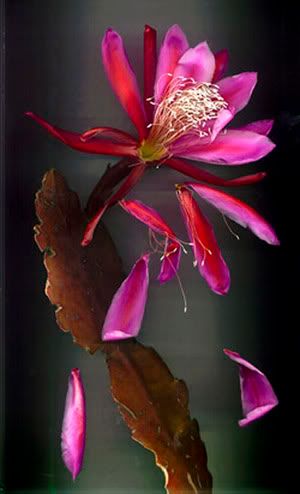
Jane O'Neal, Orchid Cactus Flower #3,
2009, archival inkjet print, 44" x 30"
by: Shana Nys Dambrot
Jane O’Neal acquits her flatbed scanned portraits of flora and root systems with whiffs of the semi-clinical, sexualized near-abstractions of Edward Weston—an obvious comparison if for no other reason than subject matter. Due to advances in technology, the feats of the flatbed scanner, and her eye for fleshy, saturated palettes, her images are undeniably literal and escape all sentimentalism. There remains a bit of a lepidopterological feeling due to the march across the wall of mostly same-size/scaled, identically-framed specimens. There is also a definite anthropomorphism to her images of roots, flowers, and vegetables, which is hardly a scarcity in art’s big book of thematic tactics, yet never gets old. In this thread are the gnarled root-fingers of Root Ball (44 x 30 inches), and the clitoral character of Blue Java Bud (44 x 30 inches) with its cauterized umbilical stem nub and enfolding husks like a carved wooden mask or tribal talisman. But many aren’t about people at all. In Orchid Cactus Flower #1 (44 x 30 inches), the waxy texture of the leaf, like star fruit, is inviting rather than threatening. It has a bit of magic to its luminosity that seems to radiate from within, its translucent flesh refracting light like glazed pigment might in a painting. The flushed and ruddy, royal purple parchment skin and dynamic fling of glistening, intense spring green on Red Onion (44 x 30 inches) is impossibly gorgeous and hasn’t a thing to do with the human body. The approach to color and texture here is a painterly one, while the detail, the sheer amount of mass and surface, that it is possible to achieve in digital photography both supports and supplants that element of her style.
O’Neal’s subjects (aside from the fact that her real subject is photography itself,) in any case her “sitters” or pretexts are, so to speak, natural models, photogenic at every instant and from any angle. But eerily, it is also clear that nothing on display is still alive. It’s all been plucked, pulled from the earth, harvested in some way; it may be ripe and even edible, but it is all already dead and dying. That’s where some of the most humanity in the work reveals itself—not on the explicitly formal level of a Weston, but on the spiritual, existential level of an organic life. Orchid Cactus Flower #3 (44 x 30 inches) is the only picture that captures movement—there are petals photographed mid-fall; very sexy hot pink petals, seductive and alluring, on their way to hitting the ground with a dramatic flair, the up-arching stalk and face/center of the bloom straining toward the “sky” with poignancy; the humanoid stance to its bodily form and pose hinting at consciousness. This image is Romantic almost to the point of the tragic, chronicling the closest activity these inanimates can claim to a narrative arc. The diptych Cavendish Floral Bud and Cavendish Floral Stalk (2008, 44 x 30 inches each) adds the fraught energy of relationships to this equation with its male-female pairing. A richly detailed, multi-faceted bronze, muscular husk with its disheveled mop of curly “hair” and sweet cap of green stalks rests on one side, and a more feminine form of the same species, its dusky pink flower still modest but emerging from under the protective chastity of the husk rests on the other. They are separate but eternally linked, like sides of a coin, or the gender divide they represent as metaphor and metonymy—and there is more material for sexual projection in them as any Rorschach test-giver could dream of. But then again, people seem to love to see themselves in pictures.

No comments:
Post a Comment